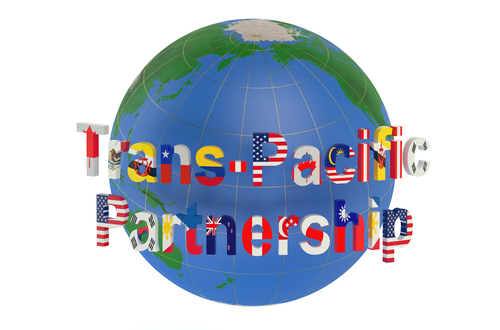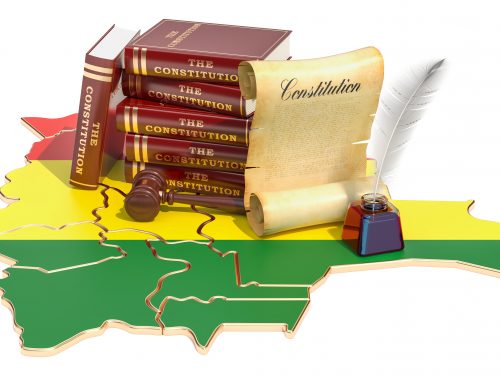
Recently, the US, Canada, Mexico, Peru, Chile, Japan, Singapore, Brunei, Vietnam, Malaysia, Australia and New Zeeland have reached an agreement of what could be the biggest Free Trade Agreement in the history of the World: the Trans-Pacific Partnership (“TPP”).
The text of the TPP has been released in November of this year and includes an IP chapter that goes far beyond the existing TRIPS agreement. Criticism against this deal has been massive and range from public health concerns1 to creation of more income inequality.2 The objective of this article is to determine first what are in general the arguments against and in favor of these TRIPS+ obligations? Second, what are the TRIPS+ obligations of the TPP on trademarks? Finally, to reach a conclusion of whether the general arguments in favor or against of TPP TRIPS+ obligations apply to the trademarks provisions.
Arguments in favor of Trans-Pacific Partnership (“TPP”):
To begin with the arguments in favor in general of TRIPS+ obligations, some economists express that the gains of society from IPRs are sufficiently attained with TRIPS standards and going further would benefit only IP intensive industries.3
Moreover, provisions that increase IPRs can limit the positive effects of competition and free trade. 4 Some perceive that for countries like the US in which IP intensive industries represent 57.7% of their value of exports,5 TPP TRIPS+ obligations are economic nationalism rather than trade liberalization.6
In addition, TRIPS+ obligations of the TPP might be considered excessively broad. While TPP improves IPRs protection for every IP sector, it could be argued that only in those where innovation is their economic function further protection is recommended because only in these sectors more protection traduces in more incentives to innovate.
Likewise, also for IPRs sectors that incentive innovation, such outcome can be limited to industries where imitation is easy and low-cost.7 This is supported for example in the case of patents where survey evidence suggests that patent protection is not considered critical by most US firms making decision to market new products and processes, with the exception in chemical and pharmaceutical industries.8By the same token, from a legal perspective it is clear that TRIPS allows WTO Members to extend a higher level of IP protection, provided that such protection does not contravene its provisions,9 but are TPP TRIPS+ a balance of rights and obligations10? Some perceive that TPP limits knowledge in excess with provisions that omit flexibilities for Internet users and technology innovators11 and is purely about strengthening IP monopolies.12
Also, it can be asserted that an international IP treaty is not the adequate legal mechanism for TRIPS+ commitments. As economies mature to higher levels of technological capacity, more domestic firms favor effective IPRs. Therefore, this finding suggests that the appropriate policy for rising IPRs is to wait until income levels rise enough that there is an automatic rise in standards.13 Setting higher standards for IP internationally carries the risk of getting caught up in economic nationalism and industrial policy, rather than to strike an adequate balance between rights and obligations.14 Some cut-offs are accused of being arbitrary.15 For example in copyright the term of 70 years is taken from US law, that has this long period just because US Congress continues to give extensions so Disney never looses its rights over Mickey Mouse.16
On the contrary, in favor of the TPP TRIPS+ stand macro, micro and country case studies that show a tendency for IPR protection to deliver positive economic results. 17
Also, adopting more uniform standards of protection will prevent consumers from suffering in some countries where because of their weak standards, world´s innovation is not aimed at their needs. 18 There is ample evidence that inventive firms in developed economies bias their research programs toward products and technologies for which they expect a large global demand and that may be protected through IPRs.19 A disproportionately small amount of global RD is focused on the needs of developing economies with low incomes and weak IPRs. 20 Since “weakness” is a relative concept, achieving compromises between countries that have high standards for the protection of IPRs21 and countries that have lower standards, permits leveling the playground so innovation is tailored at every party needs.22
Furthermore, having clear cutoffs on IP in an international treaty, that is more difficult to change than national law, would generate more certainty and predictability that boost investment, trade and innovation in general.23A key role of the legal system is said to be its creation of stability, as it affords people sufficient expectation that others will comply with legal rules to allow them to make plans with reasonable predictability as to outcomes. This principle is encapsulated in the notion of the “rule of law”, i.e. that society should be governed by legal rules that are clear.24 The more costly and difficult to change rules, the clearer the signal to investors.
what is really new in trademarks?
At this point is relevant to ask, what is really new in trademarks? First, the TPP extends the scope of protectable subject matter. While the TRIPS allowed Members to establish as condition for registration that signs are visually perceptible,25 the TPP expressly establishes that Parties cannot require as a condition for registration that a sign be visually perceptible, opening the door for registration of sounds or scents.26
In addition, there are differences in the procedural aspects of opposition. While TRIPS only considered that Members could afford opportunity to oppose the registration of a trademark,27 the TPP goes further and makes this an obligation.28
Moreover, while the term of protection in the TRIPS is minimum of 7 years,29 in TPP the minimum is 10 years.30
In regards of well know trademarks, unlike the TRIPS,31 the TPP defines them and does not requires registration in order to provide protection. 32 Also, while in TRIPS the knowledge of a trademarks has to be considered for the Member concerned,33 the TPP makes easier to establish this status by limiting the knowledge of the well know trademark to a specific sector.
Moreover, the TPP contains a positive obligation in regards of common names while TRIPS only establishes that the agreement does not require that.
At this point, it is pertinent to question how the general arguments in favor or against of the TPP TRIPS+ obligations apply for those on trademarks? It is possible to conclude that for this sector there are more arguments in favor than against.
In regards of whether the gains of society are sufficiently attained with trademarks protection of TRIPS, it must be stressed that further protection in trademarks would produce the positive outcome of even greater fair competition. Higher standards like the possibility of registration of sounds, the possibility of opposition to the registration, the extended protection of well known trademarks and the possibility of this protection without registration traduce in even less confusion in markets.
Moreover, trademarks TRIPS+ obligations of the TPP are not excessively broad. As mentioned above, higher standards are not only advisable for IP sectors that have the economic function of encouraging innovation, but also for trademarks that have the economic function of eliminating information asymmetries and promoting fair competition. The degree of imitation of the industry is not relevant to determine to what extent trademarks are justified, because is fair competition rather than innovation what they protect. Also the trademarks TRIPS + obligations have the effect of extending protection to sectors that where ignore before. They most likely will have the effect of protecting fair competition in sectors ignored before and therefore are not excessively broad.
International IP Treaty for trademarks TRIPS+
Also, an international IP treaty is an adequate legal mechanism especially for trademarks TRIPS+ commitments. As trademark protection is not linked with innovation and technological developments, higher technological advancement not necessarily result in more firms supporting trademarks protection. Since it is always desirable to achieve higher standards in trademarks because of fair competition and is a kind of protection that is not related with innovation and technological developments, and international treaty provides an opportunity for countries to discuss and import standards that had a positive experience in partner countries. Setting trademark standards through an international treaty send stronger signals to investors because that rules are more difficult to change than national law.
In conclusion, the IP chapter of the TPP regulates IPRs in far more detail than the TRIPS. In general terms, even if the cutoffs can be consider arbitrary or are unnecessarily high, is undeniable that reaching a higher level of harmonization is beneficial for research and development because big investors would undertake projects to target the needs of all regions in the world rather than just the needs of some specially protective rich countries. Whether these standards could be a basis for further steps on the multilateral liberalization is an issue that negotiators in the far future will decide. Also, some issues remained unresolved in the TPP, like the exhaustion of IPRs. The topic has being unsettled since TRIPS negotiations, and TPP failed again to reach a compromise in this area.
Regarding the field of trademarks, the balance of TRIPS+ obligations are more clearly positive in their effects. This reflects that an analysis on the convenience of new standards depends on each new obligation, and general judgments on the convenience of the treaty or in an IPRs sector risks to be inaccurate.
1 Public Citizen, The Trans-Pacific Partnership: restricting access to affordable medicines, //www.citizen.org/tpp-public-health,
30-12-2015.
2 Public Citizen, The Trans-Pacific Partnership: More Job offshoring, more income inequality,
//www.citizen.org/Page.aspx?pid=6475, 30-12-2015.
3CATO Institute, K. William Watson, For Free Trade´s Sake, Get IP out of the TPP,
//www.cato.org/publications/commentary/free-trades-sake-get-ip-out-tpp, 4-12-2015. See also: Inu Inu Barbee and Simon Lester,
The TPP and The Future of Trade agreements, Latin American Journal of International Trade Law, Vol. 2, Issue 1, Year 2014, pg.
220, //object.cato.org/sites/cato.org/files/articles/lester-lajitl-vol2-no1-2014.pdf, 4-12-2015.
4 Maskus, Ibid, pg. 167.
5 Tom Giovanetti, “Remarks by the President of the Institute for Policy Innovation in the Intellectual Property in the Trans-Pacific
Partnership: National Interest or Corporate Handout? Forum at CATO Institute, accessed online at
//www.cato.org/events/intellectual-property-trans-pacific-partnership-national-interest-or-corporate-handout, 4-12-2015.
6 Simon Lester, Is the TPP about Free Trade or Economic Nationalism?, December 26th of 2013, //www.cato.org/blog/confused-
about-tpp-dont-worry-so-everyone-else, 4-12-2015.
7 Maskus, Ibid, pg. 146.
8 Maskus, Ibíd, pg. 149.
9 Art. 1.1 TRIPS. Also: Panel Report, Canada-Term of Patent Protection, par. 12. Panel Report, China-Intellectual Property Rights,
par. 7.513.
10 Art. 7 TRIPS. See also: US-Section 211 Appropriations Act, par. 8.57.
11 Electronic Frontier Foundation, Trans-Pacific Partnership Agreement, https://www.eff.org/es/issues/tpp, 4-12-2015.
12 Paul Krugman, TPP Take Two, The Conscience of a Liberal, The New York Times,
//krugman.blogs.nytimes.com/2015/10/06/tpp-take-two/?_r=0, 4-12-2015.
13 Keith E. Maskus, Intellectual Property Rights in the Global Economy, pg. 145. The author refers Evenson and Westphal (1997),
LaCroix (1992).
14CATO Institute, K. William Watson, A strong fair use provision could help balance the TPP´s Copyright Rules, September 30th
2015, //www.cato.org/publications/commentary/strong-fair-use-provision-could-help-balance-tpps-copyright-rules, 5-12-2015.
15 K. William Watson, “Remarks by the Trade Policy Analyst in the Intellectual Property in the Trans-Pacific Partnership: National
Interest or Corporate Handout? Forum at CATO Institute”, accessed online at //www.cato.org/events/intellectual-property-trans-
pacific-partnership-national-interest-or-corporate-handout, 4-12-2015.
15 Simon Lester, Is the TPP about Free Trade or Economic Nationalism?, December 26th of 2013, //www.cato.org/blog/confused-
about-tpp-dont-worry-so-everyone-else, 4-12-2015.
16 K. William Watson, Ibid, 4-12-2015.
17 OECD, Working Party of the Trade Committee, Ricardo H. Cavazos Cepeda, Douglas C. Lippoldt and Jonathan Senft, Trade and
Agriculture Directorate Trade Committee, Trade Policy Working Paper No. 104, POLICY COMPLEMENTS TO THE
STRENGTHENING OF IPRS IN DEVELOPING COUNTRIES, TAD/TC/WP(2010)12/FINAL, 14-09-2010,
//www.oecd.org/officialdocuments/publicdisplaydocumentpdf/?cote=TAD/TC/WP(2010)12/FINAL&doclanguage=en, 5-12-
18 Maskus, Ibid, pg. 156 quoting Diwan and Rodrik (1991).
19 Maskus, Ibid, pg. 156.
20 Maskus, Ibid, pg. 156.
21 35 USC 101, https://www.law.cornell.edu/uscode/text/35/101, 5-12-2015. Also: Japan Patent Act No. 121 of 13 April 1959 as last
amended in 2006, //www.wipo.int/wipolex/en/text.jsp?fileid=188310#LinkTarget1839, 5-12-2015.
22 Public Citizen, Trans-Pacific Partnership Agreement: Harmful provisions for access to medicines,
https://www.citizen.org/documents/specific%20provisions%20final%20draft%20w.o.pdf, 5-12-2015. Lower standards than US:
Malaysia, Peru, Singapore, Vietnam, Brunei Darussalam, New Zeeland, Canada and Mexico
23 Peter Van den Bossche and Werner Zdouc, The Law and Policy of the World Trade Organization, pg. 953.
24 Alexandra George, Cambridge University Press, Constructing Intellectual Property, The metaphysics of Intellectual property, pg.
130,
https://books.google.es/books?id=q0MhAwAAQBAJ&pg=PA130&lpg=PA130&dq=predictability+of+intellectual+property&source=
bl&ots=lGfmooJk1_&sig=zxhjaqJowG3h0BkvmM8FoU-
QIgw&hl=es&sa=X&ved=0ahUKEwiQpcWJ6MPJAhWCLBoKHRQwBqkQ6AEIQDAE#v=onepage&q=predictability%20of%20int
ellectual%20property&f=false, 5-12-2015.
25 Art. 15.1 TRIPS
26 Art. 18.18 TPP.
27 Art. 15.5 TRIPS.
28 Art. 18.23 TPP.
29 Art. 18 TRIPS.
30 Art. 18.26 TPP.
31 Art. 16 TRIPS.
32 Art. 18.22.2 TPP.
33 Art. 16 TRIPS.
34 Art. 18.22.2 TPP.
35 Art. 24.6 TRIPS.




